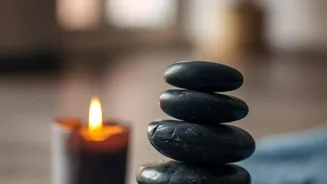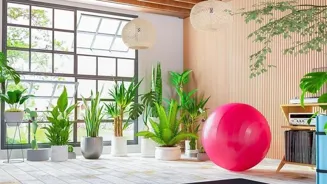Transform your home into a stress-free sanctuary with these 5 tips! Dive in to create a tranquil haven
In today's fast-paced world, where traffic jams are a daily ritual and work deadlines loom like hungry
monsters, finding a haven of peace is more important than ever. Your home should be that sanctuary, a place where you can truly unwind and recharge.
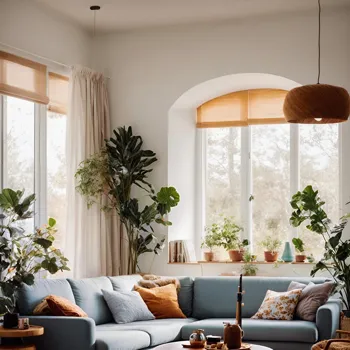
But often, it ends up becoming another source of stress, cluttered with reminders of pending tasks and overflowing with chaos. Fear not! Creating a stress-free environment at home is achievable with a few simple tweaks and mindful practices.
Let's dive into five fantastic ways to transform your humble abode into a personal haven of tranquility.
Declutter and Organize: A Clean Home is a Clear Mind
Imagine walking into a room where everything has its place, where surfaces are clear and the air feels light. That's the power of decluttering and organizing! Start small, perhaps with one drawer or a single shelf.
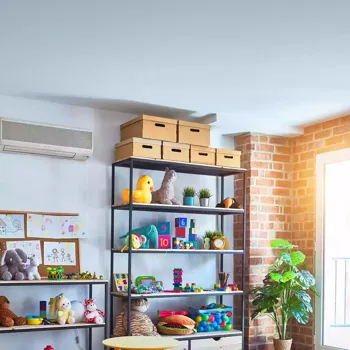
The KonMari method, made famous by Marie Kondo, suggests holding each item and asking yourself if it "sparks joy." If it doesn't, thank it for its service and let it go. Donate unwanted items to charity shops or sell them online – giving them a new life and decluttering your space simultaneously.
Invest in storage solutions like baskets, boxes, and shelves to keep things neatly tucked away. A visually clutter-free environment translates to a mentally clutter-free environment, reducing stress and promoting a sense of calm.
Remember, this isn't about achieving minimalist perfection; it's about creating a space that feels comfortable and functional for you.
A cluttered home often leads to a cluttered mind. When our surroundings are disorganized, our thoughts can become scattered and overwhelmed.
A clean and organized space promotes a sense of control and order, reducing feelings of anxiety and stress. Imagine the peace of mind you'll experience when you know exactly where everything is and don't have to spend precious time searching for misplaced items.
This organized approach helps in managing the chores and tasks in an orderly fashion.
Decluttering is not just about getting rid of things; it's about making conscious choices about what you want to keep in your life.
It's about creating a space that reflects your values and supports your well-being. Think of your home as a blank canvas, and each object you choose to keep is a brushstroke that contributes to the overall picture.
By carefully curating your belongings, you can create a space that inspires creativity, promotes relaxation, and fosters a sense of peace. Remember that decluttering and organizing are not one-time tasks but ongoing processes.
Schedule regular maintenance to keep your home clutter-free and maintain a sense of calm in your life.
Moreover, when you declutter, you open up physical and mental space for new opportunities and experiences.
By releasing the attachment to material possessions, you create room for growth and personal development. You might discover hidden talents, pursue new hobbies, or simply find more time to spend with loved ones. Decluttering is an investment in your well-being, both physically and emotionally.
Bring Nature Indoors: The Healing Power of Greenery
Studies have shown that spending time in nature reduces stress hormones and promotes a sense of well-being. Since heading to a forest every day might not be feasible, bring the forest to you! Incorporate houseplants into your décor. Even a small potted plant on your desk can make a difference.
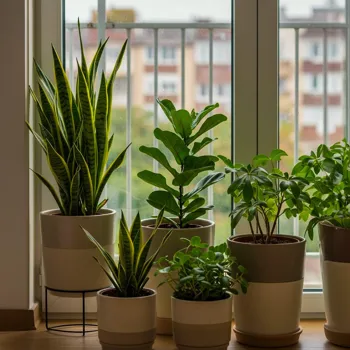
Plants not only purify the air but also add a touch of life and vibrancy to your space. Choose plants that are easy to care for, such as snake plants, spider plants, or ZZ plants. If you have a green thumb, consider starting a small herb garden on your balcony or windowsill.
The aroma of fresh herbs can be incredibly soothing and uplifting. You can also incorporate natural elements like wood, stone, and bamboo into your décor to create a connection with the outdoors.
The presence of plants in your home can significantly enhance your mood and reduce stress levels.
Plants release oxygen and absorb carbon dioxide, improving the air quality in your home. They also help to reduce levels of harmful pollutants, creating a healthier and more comfortable living environment.
Moreover, the simple act of caring for plants can be therapeutic and grounding, providing a sense of purpose and connection to nature.
Beyond their practical benefits, plants add a touch of beauty and elegance to any space.
Their vibrant colors and unique textures can transform a dull room into a vibrant oasis. Choosing the right plants for your home can also reflect your personal style and create a welcoming and inviting atmosphere.
Whether you prefer lush tropical foliage or delicate flowering plants, there's a plant out there for everyone.
Incorporating natural light into your home is just as important as bringing in greenery. Open your curtains and let the sunlight stream in.
Natural light is a powerful mood booster and can help to regulate your sleep-wake cycle. If you don't have access to much natural light, consider using full-spectrum light bulbs to mimic the effects of sunlight.
Create a Sensory Oasis: Engage Your Senses for Relaxation
Think about what makes you feel calm and relaxed. Is it the scent of lavender, the sound of gentle rain, or the feel of a soft blanket? Engage your senses to create a sensory oasis in your home.

Use aromatherapy diffusers with essential oils like lavender, chamomile, or sandalwood to create a calming atmosphere. Play soothing music or nature sounds to drown out the noise of the outside world. Invest in soft, comfortable blankets and pillows that you can snuggle up with.
Create a designated relaxation zone where you can escape from the stresses of daily life. This could be a cozy corner with a comfortable armchair, a meditation space with a yoga mat, or a bathtub where you can soak away your worries.
A sensory oasis is a personal space designed with the specific intention to soothe and rejuvenate your senses. It's a place where you can disconnect from the demands of the outside world and reconnect with yourself.
By engaging your senses in a positive and intentional way, you can create a sense of calm and well-being.
The sense of smell is particularly powerful when it comes to triggering emotions and memories.
Use essential oils that are known for their calming and relaxing properties, such as lavender, chamomile, and sandalwood. You can diffuse these oils in the air, add them to a bath, or apply them directly to your skin (diluted in a carrier oil).
The sense of sound can also have a profound impact on your mood. Play soothing music, nature sounds, or guided meditations to create a relaxing atmosphere. You can also invest in a white noise machine to help block out distracting noises.
Designate Zones: Separate Work from Rest
One of the biggest challenges of working from home is blurring the lines between work and personal life. It's crucial to designate specific zones for different activities. If possible, have a separate room or area for your workspace. This helps to mentally separate work from rest.
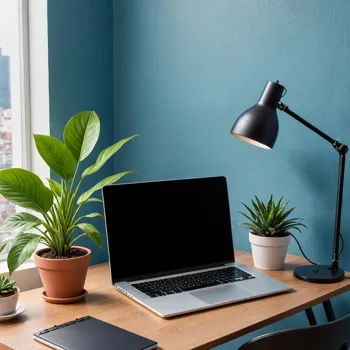
When you're in your designated workspace, focus on work. And when you're in your relaxation zone, focus on relaxing. This helps prevent work from creeping into your downtime and vice versa.
If you don't have a separate room, try using screens or furniture to create a visual barrier between your workspace and your living space. Remember to switch off notifications from work-related apps and email accounts when you're not working. This will help you disconnect and fully relax.
It might sound easy in theory, but setting up physical boundaries is helpful to separate work from personal life. Ensure that you do not mix up work and personal chores
Creating a work-free zone is essential for maintaining a healthy work-life balance.
This is a space in your home where you can completely disconnect from work and focus on relaxing and recharging. This could be your bedroom, your living room, or even just a specific corner of your home that you designate as a work-free space.
Practice Mindfulness and Gratitude: Cultivate Inner Peace
Creating a stress-free environment is not just about the physical space; it's also about cultivating inner peace. Practice mindfulness by paying attention to the present moment without judgment.

Take a few minutes each day to meditate, do some deep breathing exercises, or simply sit in silence and observe your thoughts and feelings. Keep a gratitude journal and write down things you're grateful for each day.
This helps to shift your focus from what's lacking in your life to what you already have. Practice self-compassion by treating yourself with kindness and understanding, especially during difficult times. Remember, creating a stress-free environment is an ongoing process, not a destination.
Be patient with yourself and celebrate small victories along the way.
Mindfulness is the practice of paying attention to the present moment without judgment. It's about being fully aware of your thoughts, feelings, and sensations as they arise, without getting carried away by them.
Mindfulness can be practiced through meditation, but it can also be incorporated into your daily activities, such as eating, walking, or washing dishes.
Gratitude is the practice of focusing on the positive aspects of your life and appreciating what you have.
It's about recognizing the good things in your life, both big and small, and expressing your thankfulness for them.
Gratitude can be practiced by keeping a gratitude journal, expressing your appreciation to others, or simply taking a few moments each day to reflect on the things you're grateful for.
By practicing mindfulness and gratitude, you can cultivate a sense of inner peace and resilience, which will help you to navigate the stresses of daily life with greater ease. Remember there are multiple channels available online.
You can get coaching from a certified coach via online to achieve the right result.
Your Home, Your Sanctuary
Transforming your home into a stress-free environment is a journey, not a destination. Experiment with these tips and find what resonates with you.
Remember, the goal is to create a space that supports your well-being, promotes relaxation, and allows you to recharge. With a little effort and mindful attention, you can turn your house into a true home sanctuary. Good luck on building your home sanctuary!

